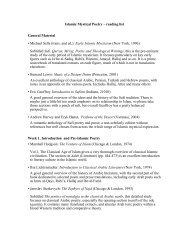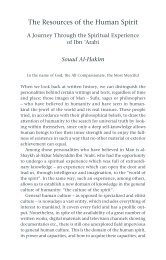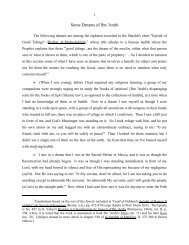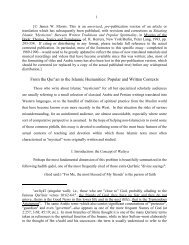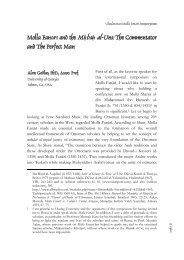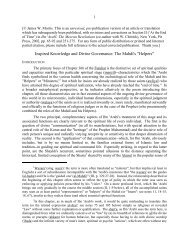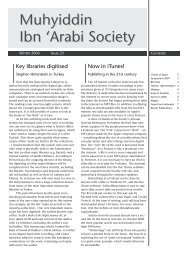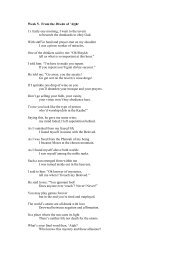Part III (pdf) - Muhyiddin Ibn Arabi Society
Part III (pdf) - Muhyiddin Ibn Arabi Society
Part III (pdf) - Muhyiddin Ibn Arabi Society
Create successful ePaper yourself
Turn your PDF publications into a flip-book with our unique Google optimized e-Paper software.
9both personally and politically. By contrast, in <strong>Ibn</strong> ‘Arabî (e.g., Futûhât, chapters 60-64 and 371,for the most extended accounts of eschatology), what must strike any reader is the consistent andthorough ‘literality’—an attitude equally removed from Kâshânî’s ‘symbolic’ approach and fromwhat we ordinarily think of as ‘literalism’—with which the Shaykh treats the profusedescriptions given by the Qur’an and hadith, his extraordinary respect for each concrete detail inthe ‘timing’ and ‘location’ of the stages of the human being’s post—mortem existence (hisongoing development and spiritual experience in the barzakh or ‘lesser Resurrection,’ then theevents of the Greater Resurrection, then the many facets of Gehenna, the Garden, and the beatificVision). 83 When this characteristic procedure is combined with <strong>Ibn</strong> ‘Arabî’s repeated vividdescriptions of his own (or other Sufis') personal visionary experiences and encounters withmany deceased individuals (earlier masters, prophets, etc.) in the other world (barzakh), it is83 (See already the discussion of <strong>Ibn</strong> ‘Arabî’s broader attitude toward the Qur’an andhadith in <strong>Part</strong> I and at notes 10 [<strong>Part</strong> II-A above] and 75.)In metaphysical terms, one could say that the difference turns especially on their differingconceptions of what <strong>Ibn</strong> ‘Arabî calls khiyâl, in both its cosmic dimensions, on many planes ofbeing (including even the ‘material’ world); and its microcosmic, human manifestations (where‘imagination’ is both a weak and misleading equivalent, since khiyâl in this metaphysical senseunderlies absolutely all phenomena—not merely the ‘religious’ or imaginal—of experience ingeneral). For a more concrete example, one can compare <strong>Ibn</strong> ‘Arabî’s treatment of theeschatological materials of Islamic tradition with that of Ghazâlî in his Durrat al-Fâkhira fîKashf ‘Ulûm al-Âkhira (The Precious Pearl: a Translation from the <strong>Arabi</strong>c, tr. Jane Smith,Missoula, Mont., 1979 [not to be confused with Jâmî’s entirely different and much later Durratal-Fâkhira, whose translation and edition are discussed in section V. below]), a work whoserestricted exoteric rhetorical intentions and underpinnings—more or less aimed at ‘frightening’the common people (‘awâmm) into carrying out all their religious and ethical duties—are clearlyoutlined in Ghazali’s more philosophic writings (cf. n. 13, <strong>Part</strong> II-A above). It is precisely therelative separation of ‘ethical’ and ‘intellectual’ (or spiritual) planes of meaning and intention—and the consequent division of types of writing and teaching—which Ghazali took over from theAvicennan philosophy of his day that is called into question by <strong>Ibn</strong> ‘Arabî’s metaphysics and hisdistinctive understanding of prophecy and revelation in all their dimensions.The same fundamental metaphysical role of khiyâl for <strong>Ibn</strong> ‘Arabî likewise seems tounderlie his cryptic response, in his famous first encounter with the noted philosopher <strong>Ibn</strong> Rushd(Averroes), to his question whether the answer—to a mysteriously unnamed problem—achievedby illumination and inspiration was the same as that provided by rational inquiry: ‘Yes and no.Between the yes and the no, spirits take their flight from their matter and heads are separatedfrom their bodies.’ See pp. 41-2 in the English translation of H. Corbin’s Creative Imaginationin the Sufism of <strong>Ibn</strong> ‘Arabî, Princeton, 1969; a more complete translation of the same passage,from the Futûhât, I, 153-54, can also be found in Asin Palacios’ L'Islam christianisé [recentFrench translation discussed in <strong>Part</strong> I], pp. 30-31.)



